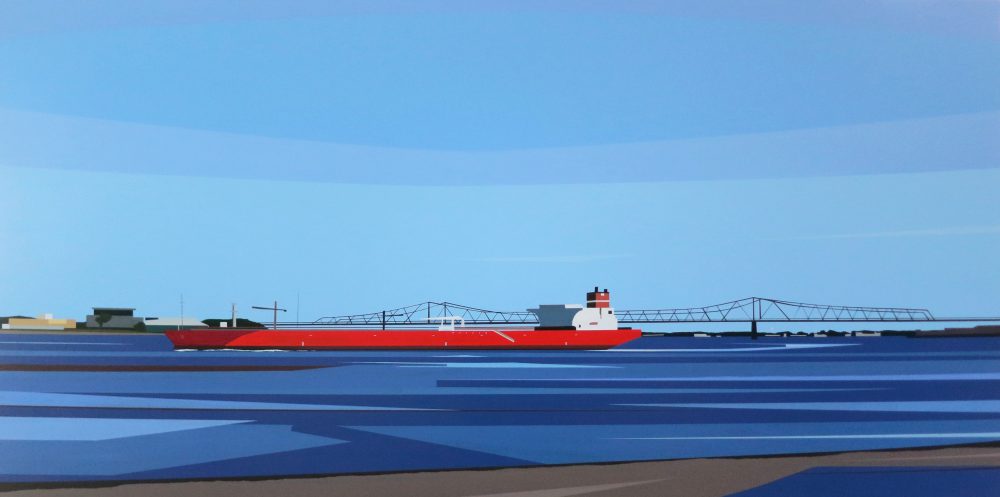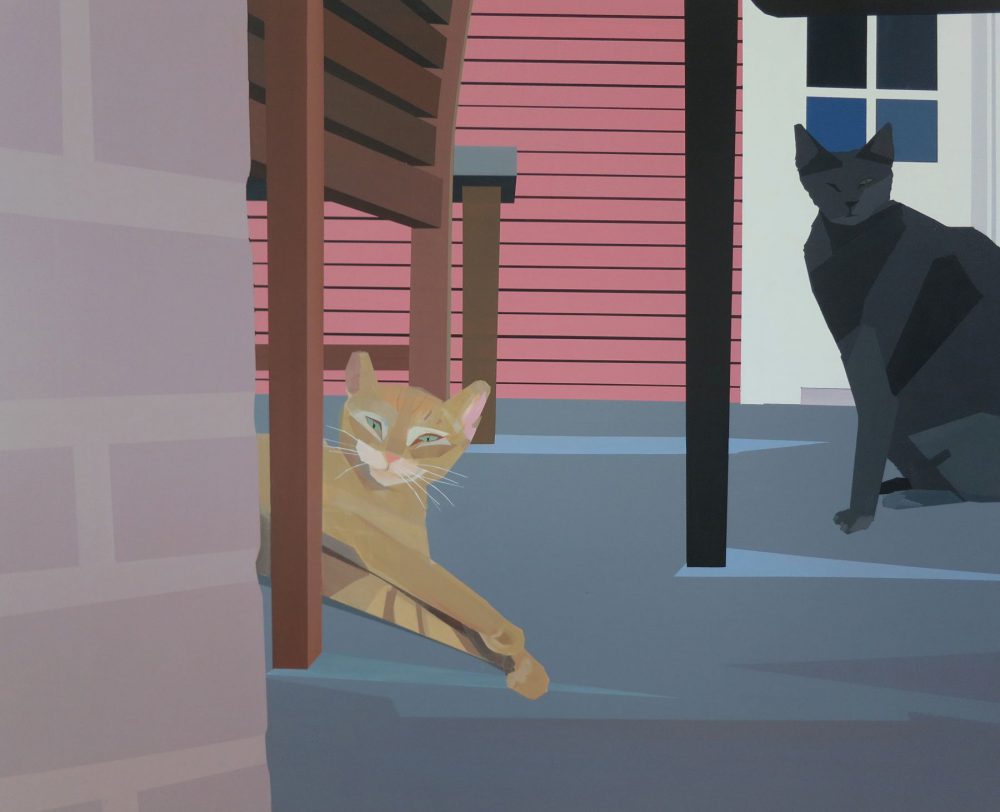An Ordered Land: Greta Van Campen at Octavia Art Gallery
Looking at Greta Van Campen’s paintings at Octavia Art Gallery, Jacob Kiernan questions the tidiness of Modernism and its relationship to New Orleans.

Greta Van Campen, Woldenberg Park, 2015. Acrylic on panel. Courtesy the artist and Octavia Art Gallery, New Orleans.
Has the world become an impossible labyrinth? Everyone walks around with phones attached to their faces. Without Siri, I wouldn’t know how to get to the market. Sometimes it seems we can no longer get anywhere without an app, yet we rarely allow ourselves the admittedly frightening opportunity to get lost.
Greta Van Campen, in her new exhibition at Octavia Art Gallery, strives for a neatly ordered landscape. A boxy butter yellow home stands squarely in the center of one canvas. A rectilinear tanker navigates the unpopulated shores of the Mississippi in another. The Lake Pontchartrain Causeway extends endlessly towards a placid sky. Van Campen’s style is all crisp lines and clean colors to show a world tidier than our own.
This orderliness can be comforting. Her clouds are frozen in a state of calm collect; her paintings awake a feeling of tranquility. While the exhibition comprises only New Orleans landscapes, her other paintings of California and of Maine, where she lives and works, share that serenity.

Greta Van Campen, Cats of New Orleans, 2015. Acrylic on panel. Courtesy the artist and Octavia Art Gallery, New Orleans.
But a subtle anxiety exists under the surface of Van Campen’s landscapes—an anxiety of influence. It’s difficult not to see Charles Sheeler’s chunky buildings behind her facades, David Hockney’s blocks of vibrant color. And though not on view here, Van Campen’s 2015 Ferry Terminal, Portland is uncomfortably similar to Ed Ruscha’s 1966 Standard Station.
In The Anxiety of Influence, Harold Bloom argues that poets are inevitably influenced by those who come before them. However, a critical step in producing original work is creative “misreading.” The poet must alter the devices of past poems in order to find personal expression. Van Campen’s problem is that she is too close of a reader. She so adeptly appropriates and incorporates her influences that there is little room for imagination.
Accordingly, Sheeler and Ruscha lend a historically male authority to apply her Modernist style to any location. Her paintings of Portland, Wyoming, and Lake Michigan share the same clean shapes, sharp lines, and pastel colors as her New Orleans landscapes. Surely many great painters have distinctive styles that bring something out of their varied subjects that would otherwise be missed. But when imposed upon New Orleans, Van Campen’s approach sterilizes the city, turning it into a deadened vision of itself.
The problem is not that Van Campen uses the tools of Modernism to make sense of the world around her, but rather that she seems to apply this style to New Orleans without regard to the city’s grungy eccentricities. Where are the gutter punks drinking beer at eight in the morning? The multicolor flotsam and jetsam that washes up on the banks of the Mississippi? The mange on the Cats of New Orleans? All of that has been effaced. While a Maine sunset might evoke such a phlegmatic style to some, Van Campen’s polish erases the patina that gives New Orleans its character, its messiness. Ultimately, her landscapes are only heartening if you believe the city is in need of cleaning up.
Editor's Note
Greta Van Campen’s work is on view through December 5, 2015 at Octavia Art Gallery (454 Julia Street) in New Orleans.



